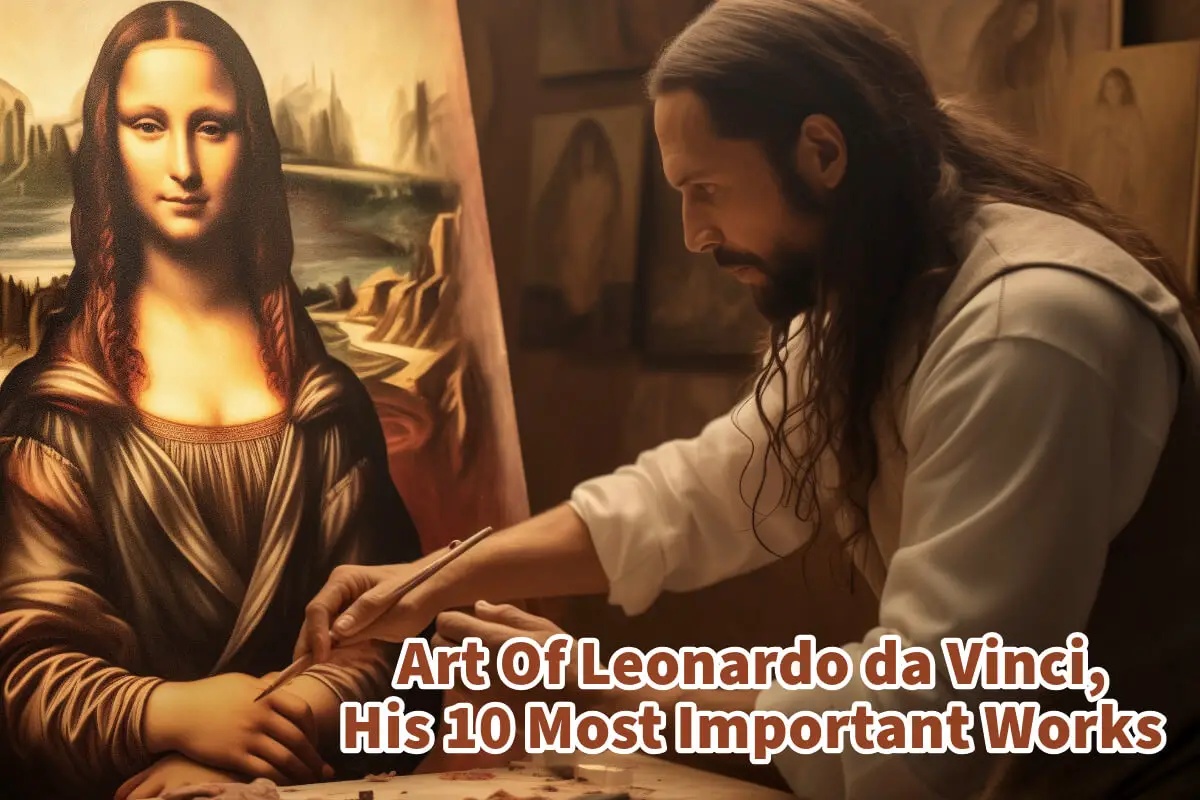Leonardo da Vinci remains one of the most celebrated artists in history, captivating the world’s imagination centuries after his death. His enduring popularity is evidenced by the high volume of internet searches for his name, underscoring people’s fascination with his life and work.
Despite his fame, Leonardo produced a relatively small body of paintings during his lifetime. Among these, the Mona Lisa and The Last Supper stand out as two of the most iconic artworks ever created, recognized and revered around the globe. However, Leonardo’s influence extends beyond these masterpieces. Several other works, either directly painted by him or thought to be influenced by his innovative techniques and visionary approach, also contribute to his legacy as a master of the Renaissance era.
Table of Contents
- The Art of Leonardo da Vinci: A Journey Through His 10 Most Important Works
- 1. Mona Lisa (La Gioconda) By Leonardo da Vinci
- 2. The Last Supper By Leonardo da Vinci
- 3. Vitruvian Man By Leonardo da Vinci
- 4. Lady with an Ermine By Leonardo da Vinci
- 5. Ginevra de’ Benci By Leonardo da Vinci
- 6. The Baptism of Christ By Verrocchio With Contribution By Leonardo da Vinci
- 7. The Adoration of the Magi By Leonardo da Vinci
- 8. St. John the Baptist By Leonardo da Vinci
- 9. Annunciation By Leonardo da Vinci
- 10. The Virgin and Child with St. Anne By Leonardo da Vinci
- Related Questions
The Art of Leonardo da Vinci: A Journey Through His 10 Most Important Works
Leonardo da Vinci, whose name resonates through the annals of art history, embodies the Renaissance man’s ideal. His unparalleled contribution to art is not only limited to the breathtaking beauty of his paintings but also to the profound impact they had on the art world and beyond.
Da Vinci was not just a painter; he was an inventor, scientist, mathematician, and philosopher who integrated his diverse knowledge into his artworks, making them visually stunning and intellectually profound.
Below, we explore ten of Leonardo da Vinci’s most important works, which stand as testaments to his genius and indelible mark on art. We include the names of each work and then list why we feel it is important.
1. Mona Lisa (La Gioconda) By Leonardo da Vinci
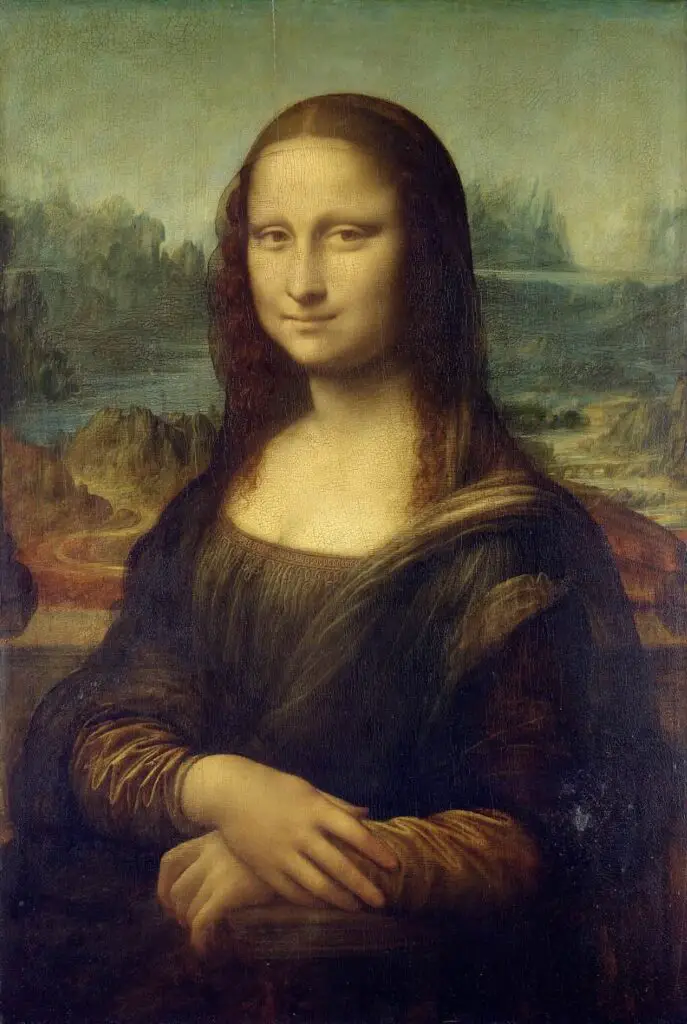
- Importance: Perhaps the most famous painting in the world, the Mona Lisa, captivates audiences with her enigmatic smile. Leonardo’s mastery of the sfumato technique, which creates a soft transition between colors and tones, contributes to the portrait’s lifelike quality. The Mona Lisa’s mysterious expression and the depth of her gaze have sparked endless discussions and theories, cementing her place as a timeless symbol of artistic perfection.
2. The Last Supper By Leonardo da Vinci

- Importance: This mural captures the moment Jesus announces that one of his twelve disciples would betray him. The work is celebrated for its emotional depth, complex composition, and the use of perspective to draw the viewer’s attention to the central figure of Jesus. Its deteriorating condition has only heightened interest in the piece, symbolizing the fragility of greatness.
3. Vitruvian Man By Leonardo da Vinci

- Importance: This drawing represents the ideal human body proportions the ancient Roman architect Vitruvius described. Leonardo’s integration of art and science exemplifies the Renaissance spirit, and the Vitruvian Man has become an icon of humanist thought, symbolizing the blend of art, science, and philosophy.
4. Lady with an Ermine By Leonardo da Vinci
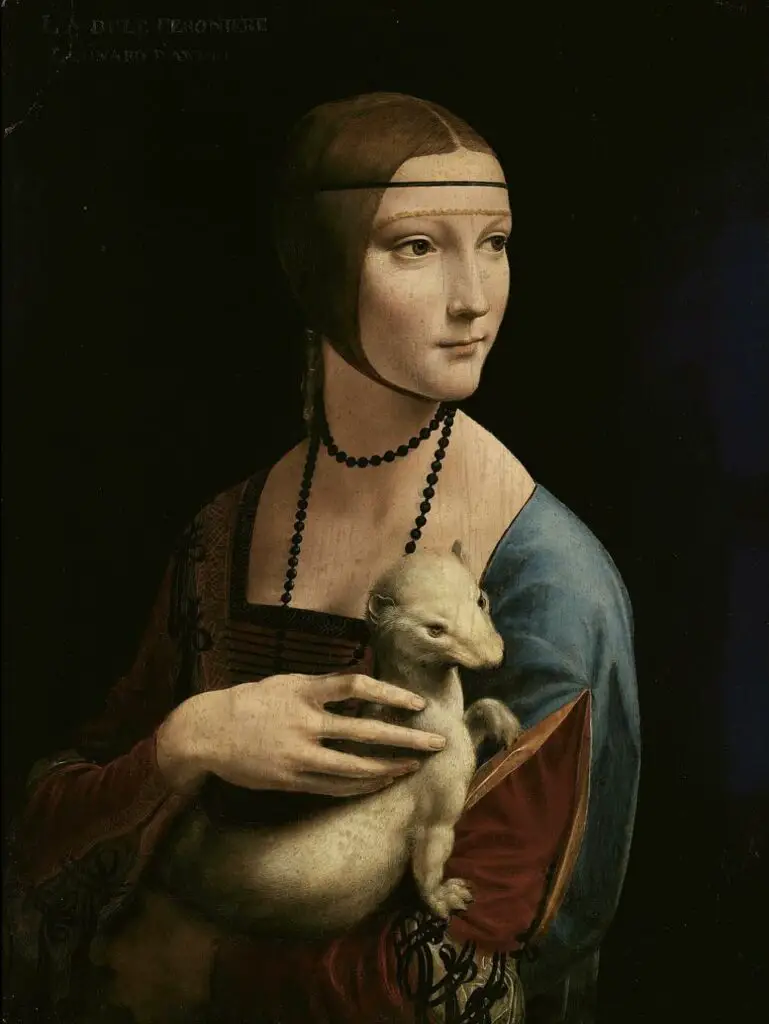
- Importance: This portrait is notable for depicting Cecilia Gallerani, showcasing Leonardo’s skill in capturing his subject’s beauty and personality. The ermine she holds symbolizes purity and a personal emblem of Ludovico Sforza, Duke of Milan, indicating the painting’s more profound layers of meaning and the artist’s attention to symbolism.
5. Ginevra de’ Benci By Leonardo da Vinci
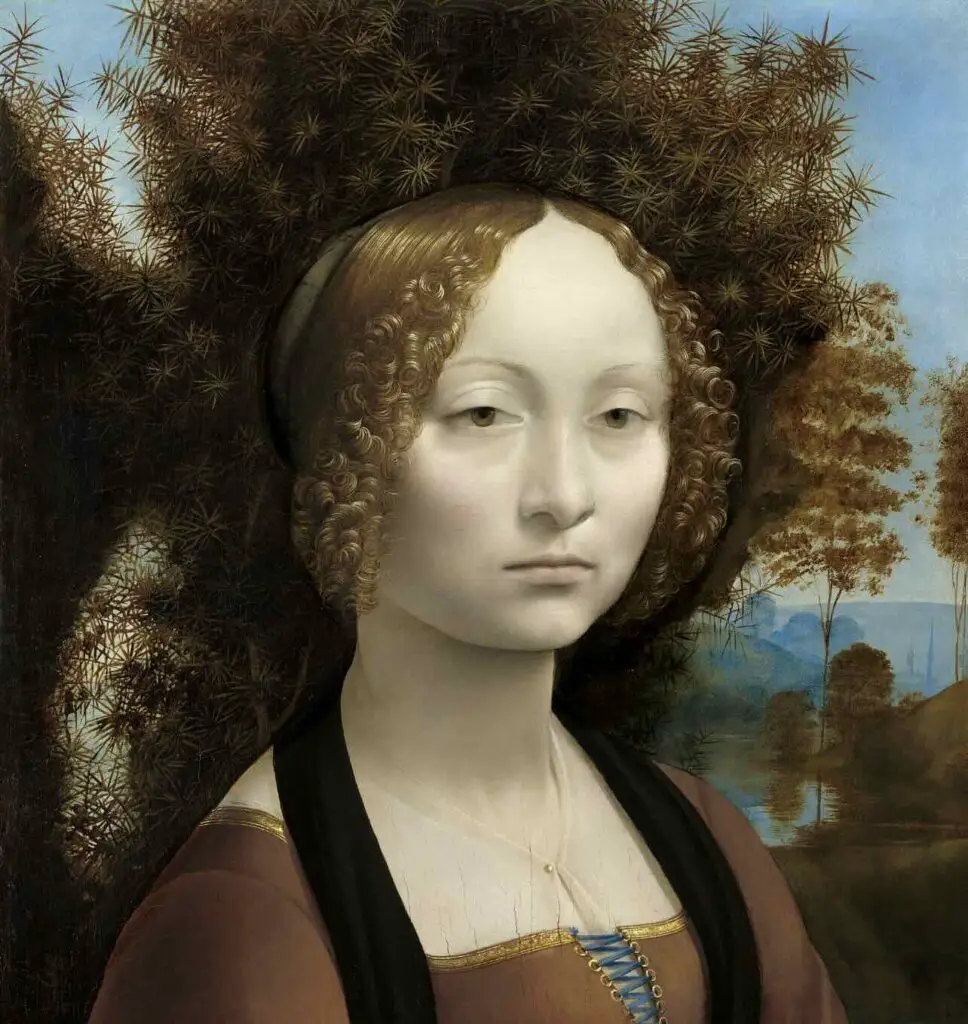
- Importance: As one of Leonardo’s earliest known portraits, this painting of a young Florentine aristocrat is a study of character and naturalism. The reverse side of the painting, which depicts a juniper bush (symbolizing chastity), bears the inscription “Virtutem Forma Decorat,” suggesting that virtue beautifies form, highlighting Leonardo’s belief in the harmony of outer and inner beauty.
6. The Baptism of Christ By Verrocchio With Contribution By Leonardo da Vinci

- Importance: Though primarily attributed to his master Verrocchio, Leonardo’s contributions to this painting, especially the young angel holding Jesus’ robe, display his early mastery of form and composition. This work marks Leonardo’s emergence in Florence’s artistic scene.
7. The Adoration of the Magi By Leonardo da Vinci
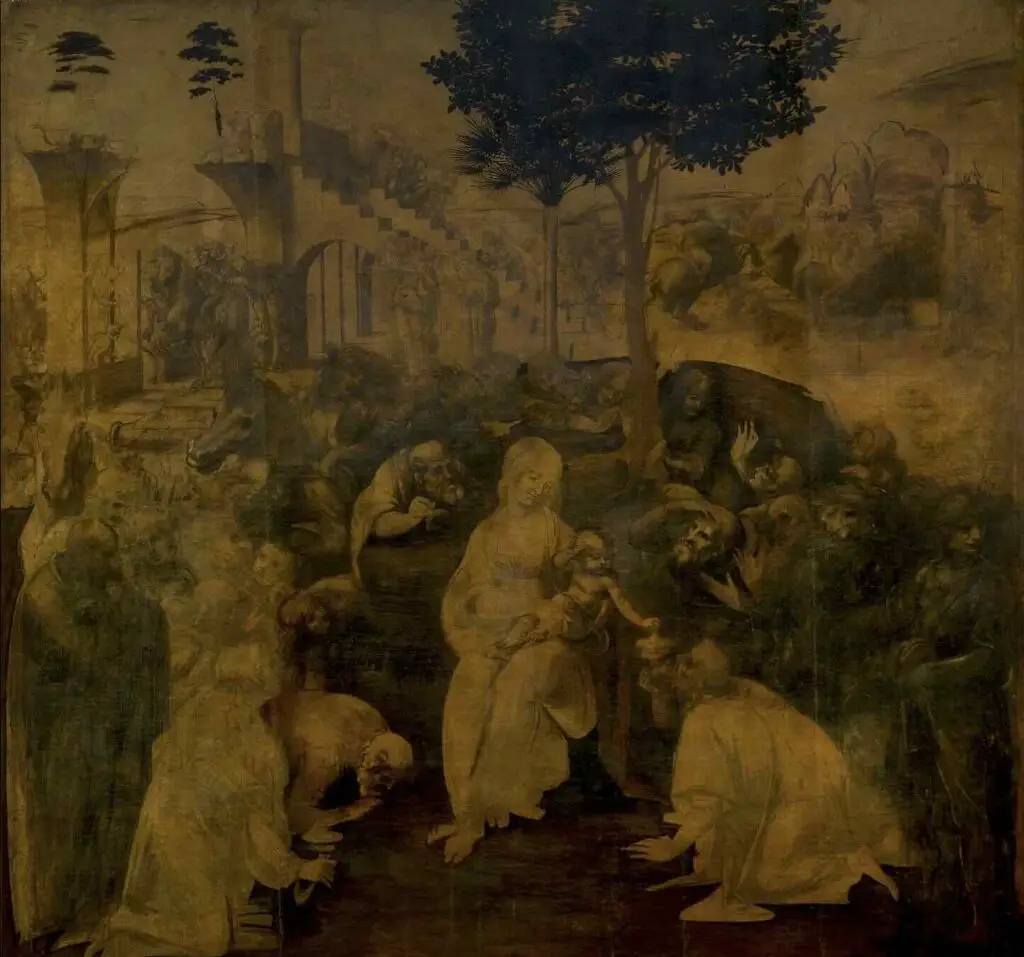
- Importance: Left unfinished, this work still illustrates Leonardo’s innovative use of perspective and his departure from traditional scene representations. His focus on psychological realism and dynamic composition broke new ground in depicting biblical narratives.
8. St. John the Baptist By Leonardo da Vinci

- Importance: Leonardo depicted a smiling St. John the Baptist in his later years, whose pointing gesture towards heaven embodies the Renaissance theme of the connection between Earth and the divine. Using chiaroscuro and sfumato techniques, the figure has an almost ethereal presence.
9. Annunciation By Leonardo da Vinci

- Importance: This early work by Leonardo showcases his keen observation of nature and his delicate handling of detail, particularly in the angel’s wings and the garden. With its precise perspective, the composition invites the viewer into the scene, making it a significant piece in Leonardo’s exploration of religious themes.
10. The Virgin and Child with St. Anne By Leonardo da Vinci
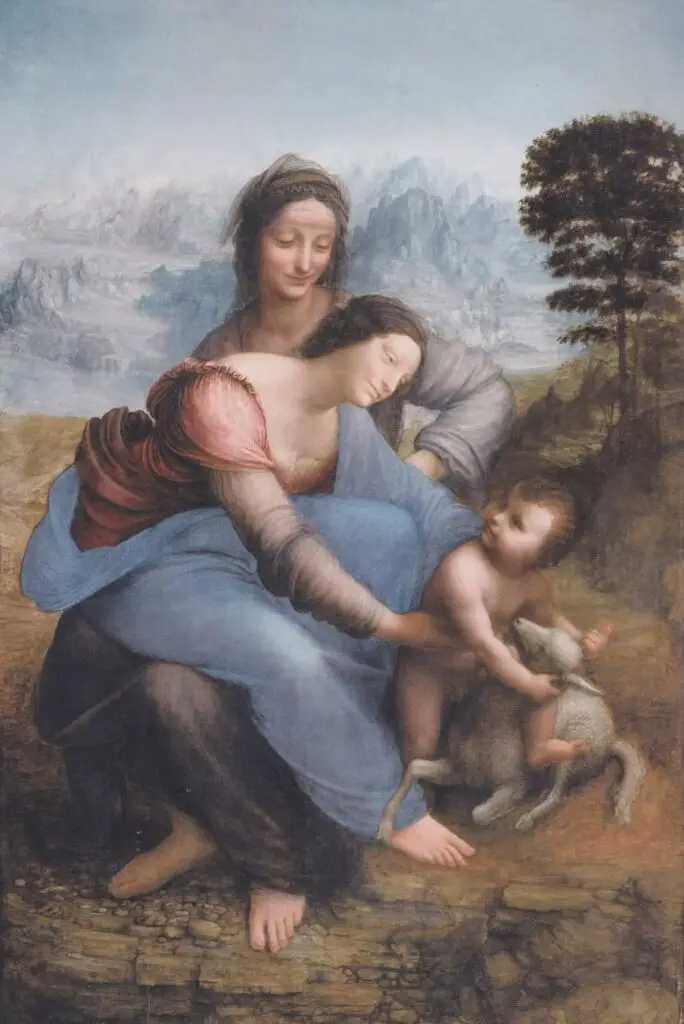
- Importance: This painting illustrates Leonardo’s skill in creating a sense of depth and realism through composition and color. The intimate grouping of St. Anne, the Virgin Mary, the Christ Child, and a lamb symbolizes both the human and divine aspects of Jesus’s nature, reflecting Leonardo’s continuous exploration of theological themes.
Leonardo da Vinci’s works are more than just visually stunning pieces; they are profound explorations of human experience, emotion, and intellect. His ability to blend scientific inquiry with artistic genius set new standards for art, making him one of the most influential figures in the history of Western art.
Leonardo continues to inspire generations through his paintings, inviting us to look closer, think more profoundly, and appreciate.
Anita Louise Art is dedicated to art education, great artists, and inspiring others to find and create their art. We love art that uplifts and inspires. #ArtToMakeYouSmile! #ArtToMakeYouHappy!
If you want to see any of my art, you can find out more by clicking here. If you are interested in what inspires me and my paintings, you can discover more by clicking here.
We have a free newsletter and would love you to be part of our community; you can subscribe to the newsletter by clicking here. I would be happy to talk to you if you have any questions. You can reach me, Anita, by clicking here.
Subscribe to our Anita Louise Art YouTube Channel filled with great videos and information by clicking here.
Join us for our podcast “5 Minutes With Art.” Spend 5 minutes a week with us to discover and learn about great art and artists. You can find out more about our podcast by clicking here.
Related Questions
12 Years Leonardo Painted Mona Lisa’s Lips, Facts Or Fiction?
There is no evidence to show that Leonardo da Vinci spent 12 years painting the Mona Lisa smile. Most scholars believe that he painted the painting in 4 years but then had the painting much longer in his possession. He could have worked on it a bit or adjusted it when he had it in his possession, but there is no evidence to show that.
By clicking here, you can learn more by reading 12 Years Leonardo Painted Mona Lisa’s Lips, Facts Or Fiction?
Who Is Mona Lisa? Unveiling The Enigmatic Portrait
Many believe that the Mona Lisa is the portrait of Madam Lisa Giocondo. While the woman’s true identity in the painting has remained a subject of debate and speculation, it is widely believed that Mona Lisa is a portrait of Madam Lisa Giocondo. This theory is based on the mid-sixteenth-century biography of Leonardo da Vinci by Giorgio Vasari, historical records, and circumstantial evidence.
By clicking here, you can learn more by reading Who Is Mona Lisa? Unveiling The Enigmatic Portrait.
Mona Lisa: The Most Famous Painting In The World
Painted by the legendary artist Leonardo da Vinci and completed in 1506, it is the world’s most famous and most viewed painting. However, its significance extends far beyond mere popularity. The Mona Lisa’s intriguing history, including a daring theft from the Louvre, has contributed to its enigmatic allure. Read on as we delve into the captivating story of the Mona Lisa, exploring its artistic mastery, the mesmerizing smile, and the extraordinary events that have elevated it to iconic status in art.
By clicking here, you can learn more by reading Mona Lisa: The Most Famous Painting In The World.

